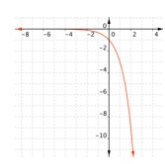HOW TO TELL IF FUNCTION IS EXPONENTIAL GROWTH OR DECAY
Subscribe to our ▶️ YouTube channel 🔴 for the latest videos, updates, and tips.
From the given function how to check if it is growth or decay ?
Every exponential function will be in the form
y = abx
Here a is the initial value and b is the growth factor or decay factor.
- If b > 1, then the function will be exponential growth function
- If 0 < b < 1, then the function will be exponential decay function.
From the given graph how to check if it is growth or decay ?

- While observing the graph from left to right, if it goes up, then it will be exponential growth function.
- While observing the graph from left to right, if it goes down, then it will be exponential decay function.
Tell whether the equation or graph represents an exponential growth or exponential decay function.
Problem 1 :
y = 5(0.4)x
Solution:
y = a(b)x
a = 5
b = 0.4
0 < b < 1
So, it is exponential decay function.
Problem 2 :
y = -3(7/2)x
Solution:
y = a(b)x
a = -3
b = 7/2 = 3.5
b > 1
So, it is exponential growth function.
Problem 3 :

Solution:
While observing the graph from left to right, it goes up. Then it must be exponential growth function.
Problem 4 :
y = 9(1.5)x
Solution:
y = a(b)x
a = 9
b = 1.5
b > 1
So, it is exponential growth function.
Problem 5 :

Solution:
By observing the graph, it goes up. So, it is increasing function.
initial value a is -3.
y = abx ---(1)
Choosing the point (-1, -9) and applying in the function, we get
y = -3 bx
-9 = -3 b-1
-9 = -3 (1/b)
3 = 1/b
b = 1/3
By applying all the values in (1), we get
y = -3(1/3)x
By considering the base it must be exponential decay, but there must be a reflection since we have negative coefficient.
Problem 6 :
y = 0.2(0.3)-x
Solution:
Here b = 0.3 which is in between 0 and 1. But we have negative in the power.
y = 0.2(3/10)-x
y = 0.2(10/3)x
10/3 is greater than 1, so it is exponential growth function.
Problem 7 :
y = -3(6)x
Solution:
y = a(b)x
a = -3
b = 6
b > 1
So, it is exponential growth function.
Problem 8 :

Solution:
By observing the graph from left to right, it goes down. So, it is exponential decay function.
Subscribe to our ▶️ YouTube channel 🔴 for the latest videos, updates, and tips.
Recent Articles
-
Finding Range of Values Inequality Problems
May 21, 24 08:51 PM
Finding Range of Values Inequality Problems -
Solving Two Step Inequality Word Problems
May 21, 24 08:51 AM
Solving Two Step Inequality Word Problems -
Exponential Function Context and Data Modeling
May 20, 24 10:45 PM
Exponential Function Context and Data Modeling